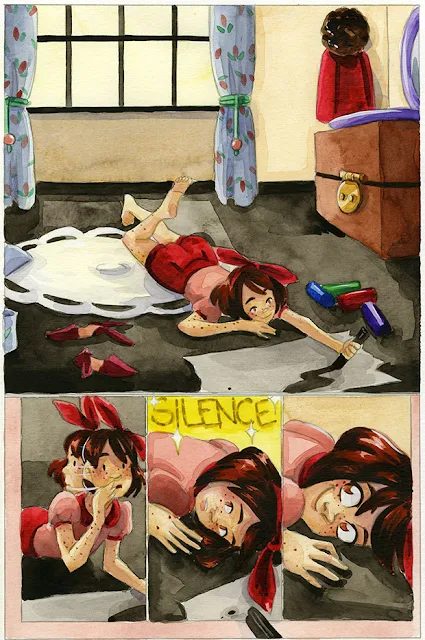The Finish On Your Comic: Intro to Comic Craft
Love comics? Don't forget to check out 7" Kara, now available as a webcomic!
Now that our roughs are finished, it's time to talk about the last stages of comic production- pencils, inks, colors, lettering. Before we determine which media to use, there are several considerations. To be honest, these are factors that should have been considered from the earliest stages, and should be an integral part of planning and executing your comic, but they are most pressing at this stage. Below is a brief outline of considerations- it is no means in depth.
Considerations:
How do you wish to publish and distribute your comic?
Web publication
- Where do you plan on hosting?
- Some platforms prioritize certain formats, like Tapas and Webtoons prioritize scrolling comics, and comics should be designed for this layout ahead of time.
- Color tends to fare better than black and white for popularity on the web
- Traditional media can be quite time consuming, and may require a significant buffer
- Web publication tends to be
- Daily
- Multiple times a week
- Weekly
- Bi Weekly
- Monthly- in batch
Print publication
- Color is more expensive to print than black and white
- Color tends to appeal to younger audiences, older audiences may be open to black and white
- Color makes for an enticing display
- Printing generally requires at least one round of proofs
A combination? Over the years, Nattosoup Studio Art and Process Blog has hosted many Kickstarter promotions that focus on bringing a webcomic to print. Check out our Intro to Comic Craft hub page to see how those artists handle the challenges of printing and publishing.
Do you plan on self publishing, or trying to pitch your comic to a publisher?
Pitching:
- Some companies prefer not to handle traditional media
- Having a short comic as proof of concept, rather than a massive comic, may be an easier pitch
Self Publishing:
- Need some capitol to publish your book
- Need to develop an audience beforehand
- Need venues to sell your comic
Print on Demand:
- More expensive per book than bulk printing, but can order small batches
- Less margin for profit/repayment on your time investment
Bulk Printing:
- Need somewhere to store your books
- Need capitol to purchase books
Love webcomics and art assets? Then check out Ink Drop Cafe today!
Once you've decided how you want to distribute your comic, and the accommodations you'll need to make, it's time to decide on whether you want to work with traditional materials, digital hardware, or a combination.
Traditional Media
7" Kara, Chapter 6. Watercolor.
Cicada Summer pitch. Brushpens and fude pens on plate bristol.
Pros:
- Some people genuinely prefer working with traditional materials, and find them easier to use.
- Beautiful colors and techniques
- Teaches you to make peace with imperfection
- Imperfections can often be corrected digitally
Cons:
- If you make a huge mistake, you may have to restart/reprint your page
- Requires some skill and practice ahead of time
- Require scanning
- Sometimes underappreciated
Digital Media
Digital flats for Cicada Summer pitch
Pros:
- Can make corrections almost ad infinitum
- Do not require scanning
- If working for web, work in RGB. If working for print, work in CYMK.
Cons:
- No finished 'original' to own, display, or sell
- Caters to perfectionism- may make it difficult to just get pages finished
- Inking can be frustrating
- Recreating traditional materials can be a timesink- may be faster to just work in those materials
Traditional Media:
Traditional Inks:Technical Pens
Fude Pens
Brush Pens
Brushes
Dip Nibs
Inkwash
or a combination
Color Media:
Color Pencils
Markers
Watercolors
Gouache
or a combination
Digital Media:
Digital InksPhotoshop
Manga Studio/Clip Studio Paint
Digital Flats
Paint Tool Sai
Medibang
Photoshop
Manga Studio/ Clip Studio Paint
Painter
Digital Shading
Paint Tool Sai
Medibang
Photoshop
Manga Studio
Painter
For other affordable options, check out this post by Kabocha.
You can also work in mixed media- digital sketches-traditional watercolor-digital lettering. The goal is to find a technique you are comfortable with that delivers the results you desire.
In the upcoming weeks, we'll cover quite a few of these methods in individual posts. There will be some overlap with the Watercolor Basics series, as that series is designed to teach and encourage comic artists to render their comics in watercolor.
Stages we will cover from here on:
- Converting your roughs to digital bluelines
- Printing out your bluelines for traditional media finish
- Scanning your finished inks
- Scanning your finished traditional media work
- Digital corrections for traditional media
- Digital Inking
- Digital Lettering
- Digital Flats
- Digital Shading
If these topics sound interesting or useful to you, make sure you keep an eye on this blog in the upcoming weeks, and please don't hesitate to share this post with a friend.
If you enjoy Intro to Comic Craft, you can help support my efforts here and on the channel by joining the Artnerd community on Patreon.








Comments
Post a Comment